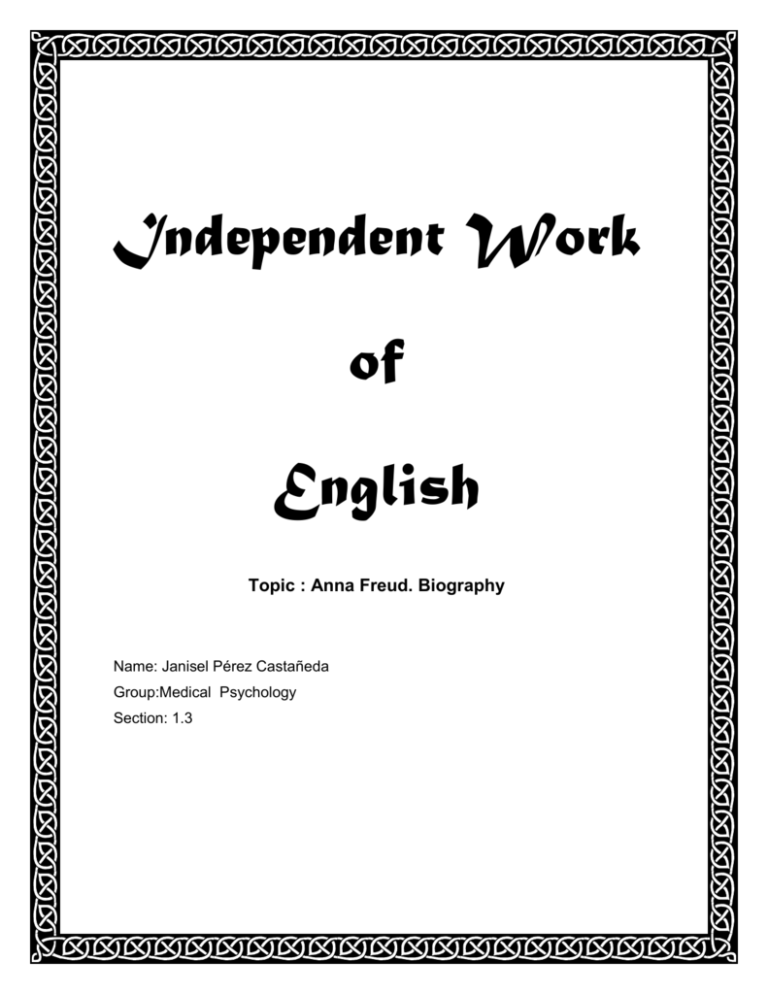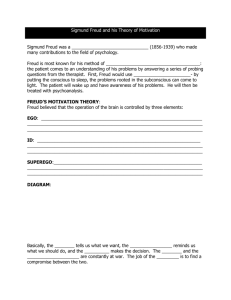Independent Work
advertisement

Independent Work of English Topic : Anna Freud. Biography Name: Janisel Pérez Castañeda Group:Medical Psychology Section: 1.3 Anna Freud: (3 December 1895 – 9 October 1982) was the sixth and last child of Sigmund and Martha Freud. Born in Vienna, she followed the path of her father and contributed to the newly born field of psychoanalysis. With Melanie Klein, she is the cofounder of psychoanalytic child psychology. Compared to her father, her work emphasized the importance of the ego and its ability to be trained socially. Freud did not have a very close bond with her mother and had difficulties getting along with her siblings, specifically with her sister, Sophie Freud. Freud also had troubles with her cousin Sonja Trierweiler. Trierweiler was a bad influence on her. Her sister, Sophia who was the most attractive child, represented a threat in the struggle for the affection of their father. Apart from this rivalry between the two sisters, Freud had some other difficulties growing up. Out of correspondence between father and daughter, it can be concluded today that Freud suffered from a depression which caused eating disorders. The relationship between Freud and her father was different from the rest of her family; they were very close. She was a lively child with a reputation for mischief. Freud wrote to his friend Wilhelm Fliess in 1899: "Anna has become downright beautiful through naughtiness... ", Sigmund was very proud of his daughter. It was found that he mentioned her in his diaries more than others in the family. Later on Freud would say that she didn’t learn much in school; instead she learned from her father and his guests at home. This was how she picked up Hebrew, German, English, French and Italian. At the age of 15, she started reading her father’s work. At a young age she started to tell her father her dreams and he would publish them in his book Interpretation of Dreams. Freud finished her education at the Cottage Lyceum in Vienna in 1912. Suffering from a depression, she was very insecure about what to do in the future. Subsequently, she went to Italy to stay with her grandmother (conflicting documents state that at this time she took a trip to England in hopes of improving her English, but was forced to leave shortly after arriving because war was declared). In 1914 she passed the test to be a trainee at her old school, the Cottage Lyceum. From 1915 to 1917, she was a trainee and then a teacher from 1917 to 1920, she finally quit her teaching career because of tuberculosis. In 1918, her father started psychoanalysis on her and she became seriously involved with this new profession. Her analysis was completed in 1922 and thereupon she presented the paper "Beating Fantasies and Daydreams" to the Vienna Psychoanalytical Society, subsequently becoming a member. In 1923, Freud began her own psychoanalytical practice with children and two years later she was teaching at the Vienna Psychoanalytic Training Institute on the technique of child analysis. From 1925 until 1934, she was the Secretary of the International Psychoanalytical Association while she continued child analysis and seminars and conferences on the subject. In 1935, Freud became director of the Vienna Psychoanalytical Training Institute and in the following year she published her influential study of the "ways and means by which the ego wards off displeasure and anxiety", The Ego and the Mechanisms of Defence. It became a founding work of ego psychology and established Freud’s reputation as a pioneering theoretician.







